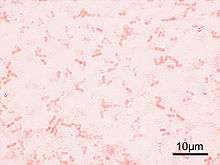Shigella flexneri
| Shigella flexneri | |
|---|---|
 | |
| Shigella flexneri Gram stain | |
| Scientific classification | |
| Kingdom: | Bacteria |
| Phylum: | Proteobacteria |
| Class: | Gammaproteobacteria |
| Order: | Enterobacteriales |
| Family: | Enterobacteriaceae |
| Genus: | Shigella |
| Species: | S. flexneri |
| Binomial name | |
| Shigella flexneri Castellani & Chalmers 1919 | |
Shigella flexneri is a species of Gram-negative bacteria in the genus Shigella that can cause diarrhea in humans. Several different serogroups of Shigella are described; S. flexneri belongs to group B. S. flexneri infections can usually be treated with antibiotics, although some strains have become resistant. Less severe cases are not usually treated because they become more resistant in the future.[1]
Discovery
The species was named after the American physician Simon Flexner; the genus is named for Japanese physician Kiyoshi Shiga, who researched the cause of dysentery.
Infectious cycle
S. flexneri contains a virulence plasmid that codes for three virulence factors: a type-3 secretion system (T3SS), invasion plasmid antigen proteins (ipa proteins), and IcsA (used for cell-to-cell spread).[2]
Upon infection, S. flexneri injects the host cell cytoplasm with ipa proteins using the T3SS—a needle-and-syringe-like apparatus common to many Gram-negative pathogens. These ipa proteins induce "membrane ruffling" by the host cell. Membrane ruffling creates membrane pockets which capture and engulf the bacteria. Once inside, S. flexneri uses host cell actin for propulsion to move directly from cell to cell using a cellular mechanism known as paracytophagy,[3][4] similarly to the bacterial pathogen Listeria monocytogenes.
S. flexneri is able to inhibit the acute inflammatory response in the initial stage of infection[5] by using an effector protein, OspI, which is encoded by ORF169b on the Shigella large plasmid and secreted by the type III secretion system. It dampens the inflammatory response during bacterial invasion by suppressing the TNF-α-receptor-associated factor 6 (TRAF6)-mediated signalling pathway.[5] OspI has glutamine deamidase activity, and is able to selectively deaminate glutamine at position 100 in UBC13 to glutamate, and this results in a failure of the E2 ubiquitin-conjugating activity which is required for TRAF6 activation.[5]
Small RNA
Bacterial small RNAs play important roles in many cellular processes. RnaG and RyhB sRNAs have been well studied in S. flexneri.[6] Ssr1 sRNA, which could play role in resistance to acidic stress and regulation of virulence was shown to exists only in Shigella.[7]
References
- ↑ Ryan KJ; Ray CG; Sherris JC, eds. (2004). Sherris Medical Microbiology (4th ed.). New York: McGraw-Hill. ISBN 978-0-8385-8529-0. LCCN 2003054180. OCLC 52358530.
- ↑ Stevens J; Galyov EE; Stevens MP (2006). "Actin-dependent movement of bacterial pathogens". Nature Reviews Microbiology. 4 (2): 91–101. doi:10.1038/nrmicro1320. PMID 16415925.
- ↑ Ogawa M; Handa Y; Ashida H; Suzuki M; Sasakawa C (2008). "The versatility of Shigella effectors". Nature Reviews Microbiology. 6 (1): 11–16. doi:10.1038/nrmicro1814. PMID 18059288.
- ↑ Robbins JR; Barth AI; Marquis H; de Hostos EL; Nelson WJ; Theriot JA (1999). "Listeria monocytogenes exploits normal host cell processes to spread from cell to cell". Journal of Cell Biology. 146 (6): 1333–1350. doi:10.1083/jcb.146.6.1333. PMC 1785326
 . PMID 10491395.
. PMID 10491395. - 1 2 3 Sanada T; Kim M; Mimuro H; Suzuki M; Ogawa M; Oyama A; Ashida H; Kobayashi T; Koyama T; Nagai S; Shibata Y; Gohda J; Inoue J; Mizushima T; Sasakawa C (2012). "The Shigella flexneri effector OspI deamidates UBC13 to dampen the inflammatory response". Nature. 483 (7391): 623–6. doi:10.1038/nature10894. PMID 22407319.
- ↑ Peng, Junping; Yang, Jian; Jin, Qi (2011-04-05). "An Integrated Approach for Finding Overlooked Genes in Shigella". PLOS ONE. 6 (4): e18509. doi:10.1371/journal.pone.0018509. ISSN 1932-6203. PMC 3071730
 . PMID 21483688.
. PMID 21483688. - ↑ Wang, Ligui; Yang, Guang; Qi, Lihua; Li, Xiang; Jia, Leili; Xie, Jing; Qiu, Shaofu; Li, Peng; Hao, RongZhang (2016-01-01). "A Novel Small RNA Regulates Tolerance and Virulence in Shigella flexneri by Responding to Acidic Environmental Changes". Frontiers in Cellular and Infection Microbiology. 6: 24. doi:10.3389/fcimb.2016.00024. ISSN 2235-2988. PMC 4782007
 . PMID 27014636.
. PMID 27014636.
External links
- "Shigella flexneri". NCBI Taxonomy Browser. 623.
- Type strain of Shigella flexneri at BacDive - the Bacterial Diversity Metadatabase